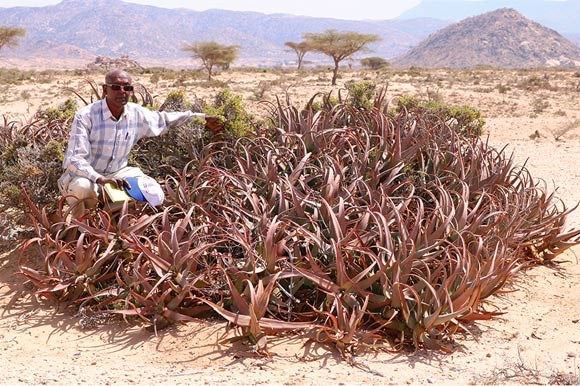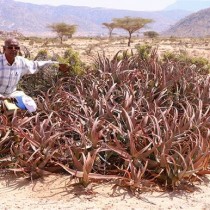
New Species of Aloe Discovered in Somaliland
The genus Aloe includes over 600 species, all native to Africa, islands in the western Indian Ocean or the Arabian Peninsula.
Its members are succulent plants with densely packed, spirally arranged leaves.
Almost all species are considered to have medicinal or cosmetic value, but a few are poisonous. Only one, Aloe vera, is widely cultivated.
The new species of aloe, named the Somali red aloe (Aloe sanguinalis), was discovered in Somaliland by Utah State University botanist Dr. Mary Barkworth and her colleagues from the University of Hargeisa and the Candlelight for Environment, Education, and Health.
"With this positive piece of information we hope that we inspire scientists to further explore the area.”
The Somali red aloe, locally known as ‘Dacar Cas’ or ‘Red Aloe,’ differs from other species of the genus in its combination of sap that is initially yellow but quickly turns bright red, drying to dark red or brownish-red, strong clump-forming habit, red teeth and paniculate inflorescence of well-spaced glabrous, red flowers.
Flowering time in this species is probably determined by the timing of the spring rains which fall between late March and early June.
"The new species is currently known from only two locations, the type locality near Alala Adka and a more northern locality near the village of Lafarug,” the researchers said.
The discovery is reported in the journal PhytoKeys.
Science News
Tuesday February 19, 2019

A species of aloe believed to be new to science has been found in Somaliland, a self-declared state, internationally considered to be an autonomous region of Somalia.
Ads By Google
"This news comes from a region which had experienced periods of conflict and instability, climate change effects and accelerated environmental degradation, whereby much of the people’s attention has been focused on promoting livelihoods and resilience,” Dr. Barkworth said.
"With this positive piece of information we hope that we inspire scientists to further explore the area.”
The Somali red aloe, locally known as ‘Dacar Cas’ or ‘Red Aloe,’ differs from other species of the genus in its combination of sap that is initially yellow but quickly turns bright red, drying to dark red or brownish-red, strong clump-forming habit, red teeth and paniculate inflorescence of well-spaced glabrous, red flowers.
Flowering time in this species is probably determined by the timing of the spring rains which fall between late March and early June.
"The new species is currently known from only two locations, the type locality near Alala Adka and a more northern locality near the village of Lafarug,” the researchers said.
The discovery is reported in the journal PhytoKeys.



 0
0 














New Species of Aloe Discovered in Somaliland
The genus Aloe includes over 600 species, all native to Africa, islands in the western Indian Ocean or the Arabian Peninsula. Its members are succulent plants with densely packed, spirally arranged leaves. Almost all species are consider